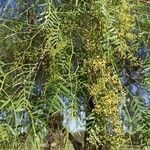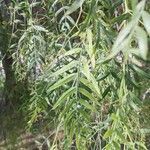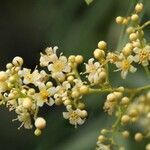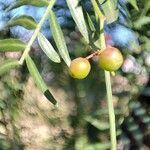Widespreading, glabrous, or minutely puberulent tree to c. 10 m high, with gnarled and twisted trunk when mature. Branchlets and lvs pendulous. Lvs imparipinnate, aromatic, 15-25 cm long; petioles 1.5-6 cm long. Leaflets 15-c. 31, alternate or opposite (terminal leaflet sometimes 0), mostly 2-5.5 × 0.25-1 cm, entire or serrate (especially on juvenile shoots), linear-lanceolate to lanceolate, acute or mucronate. Panicles large and diffuse, terminal or nearly so. Fls usually 5-merous, greenish white. Calyx c. 0.5 mm long, broad-ovate, often wider than long, often ciliolate. Petals 1.5-2 mm long, oblong-ovate or ovate. Styles < 0.5 mm long. Fr. 6-8 mm diam., shining pink.
Perennial tree, 4-11 m high; branches and foliage drooping, fruit and leaves emit peppery scent when crushed, dioecious. Leaves imparipinnate; up to 37 leaflets, greyish or light green, narrowly lanceolate, margins entire or serrated, rachis slightly winged, pubescent when young, milky latex. Flowers terminal or in axillary clusters, creamy white. Fruit a drupe, globose and slightly fleshy, pink to reddish, 1-seeded.
Introduced, evergreen tree, up to 15 m high. Branches and foliage drooping. Leaves with leaflet blade narrowly ovate, margins entire or serrate, rhachis slightly winged. Flowers: in terminal and axillary clusters; corolla dull white; Sep.-Mar. Fruit a globose, pink to reddish, slightly fleshy drupe; 1-seeded.
Schinus molle, the pepper tree, is noted for its handsome panicles loaded with yellow-ish-white flowers and the subsequent clusters of shiny, red or lavender fruits.
See Schinus molle var. areira (L.) DC.













